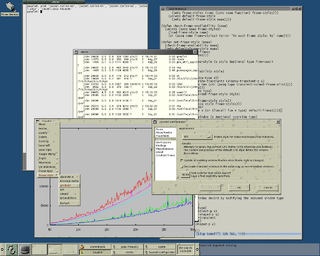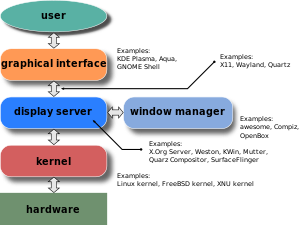In computing, a desktop environment (DE) is an implementation of the desktop metaphor made of a bundle of programs running on top of a computer operating system that share a common graphical user interface (GUI), sometimes described as a graphical shell. The desktop environment was seen mostly on personal computers until the rise of mobile computing. Desktop GUIs help the user to easily access and edit files, while they usually do not provide access to all of the features found in the underlying operating system. Instead, the traditional command-line interface (CLI) is still used when full control over the operating system is required.

In computing, a windowing system is software that manages separately different parts of display screens. It is a type of graphical user interface (GUI) which implements the WIMP paradigm for a user interface.

Sawfish is a window manager for the X Window System. It aims to manage windows in the most flexible and attractive manner possible. It is able to match a window by multiple criteria such as application, size or role, and based on this, can change the window's position, appearance, or behavior. This allows for highly customized window handling such as web browser windows opening full-screen without borders on a secondary monitor, a default terminal emulator window displaying full-screen at the desktop level, and all dialog box windows under a certain size opening on the lower right corner of the main monitor while larger ones are centered.

A stacking window manager is a window manager that draws and allows windows to overlap, without using a compositing algorithm. All window managers that allow the overlapping of windows but are not compositing window managers are considered stacking window managers, although it is possible that not all use exactly the same methods. Other window managers that are not considered stacking window managers are those that do not allow the overlapping of windows, which are called tiling window managers.

The F Virtual Window Manager is a virtual window manager for the X Window System. Originally a twm derivative, FVWM has evolved into a powerful and highly configurable environment for Unix-like systems.

A window manager is system software that controls the placement and appearance of windows within a windowing system in a graphical user interface. Most window managers are designed to help provide a desktop environment. They work in conjunction with the underlying graphical system that provides required functionality—support for graphics hardware, pointing devices, and a keyboard—and are often written and created using a widget toolkit.
In computing, the Inter-Client Communication Conventions Manual is a standard protocol for the X Window System. It specifies conventions for clients of a common X server about selections and cut buffers, communication with the window manager and session manager, manipulation of shared resources, and color characterization.
In computing, the X Window System is a network-transparent windowing system for bitmap displays. This article details the protocols and technical structure of X11.

In computing, a tiling window manager is a window manager with an organization of the screen into mutually non-overlapping frames, as opposed to the more common approach of coordinate-based stacking of overlapping objects (windows) that tries to fully emulate the desktop metaphor.
Desktop Window Manager is the compositing window manager in Microsoft Windows since Windows Vista that enables the use of hardware acceleration to render the graphical user interface of Windows.
In the X Window System, an X session manager is a session management program, a program that can save and restore the current state of a set of running applications, including window manager.
A compositing window manager, or compositor, is a window manager that provides applications with an off-screen buffer for each window. The window manager composites the window buffers into an image representing the screen and writes the result into the display memory.
A desktop environment is a collection of software designed to give functionality and a certain look and feel to an operating system.

dwm is a minimalist dynamic window manager for the X Window System developed by Suckless that has influenced the development of several other X window managers, including xmonad and awesome. It is externally similar to wmii, but internally much simpler. dwm is written purely in C for performance and security in addition to simplicity, and lacks any configuration interface besides editing the source code. One of the project's guidelines is that the source code is intended to never exceed 2000 SLOC, and options meant to be user-configurable are all contained in a single header file.
Avant Window Navigator is a dock-like bar for Linux, which sits on an edge of a user's screen and tracks open windows. Instead of representing open windows as buttons or segments on a bar, it uses large icons on a translucent background to increase readability and add visual appeal. The program was created by Neil J. Patel.
Extended Window Manager Hints, a.k.a. NetWM, is an X Window System standard for the communication between window managers and applications. It builds on the functionality of the Inter-Client Communication Conventions Manual (ICCCM).
wmctrl is a command used to control windows in EWMH- and NetWM-compatible X Window window managers. Some of its common operations are list, resize, and close window. It also has the ability to interact with virtual desktops and give information about the window manager. wmctrl is a command-line program, however, it has some functions that allow the mouse to select a window for an operation.
This article compares variety of different X window managers. For an introduction to the topic, see X Window System.

Wayland is a communication protocol that specifies the communication between a display server and its clients, as well as a C library implementation of that protocol. A display server using the Wayland protocol is called a Wayland compositor, because it additionally performs the task of a compositing window manager.

AwesomeWM is a dynamic window manager for the X Window System developed in the C and Lua programming languages. Lua is also used for configuring and extending the window manager. Its development began as a fork of dwm. It aims to be extremely small and fast, yet extensively customizable. It makes it possible for the user to manage windows with the use of keyboard.










